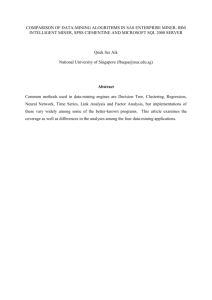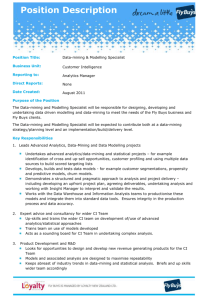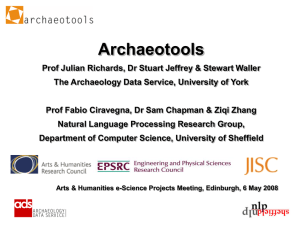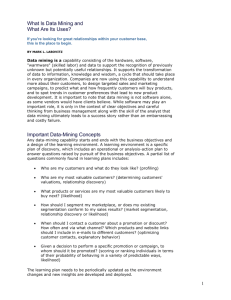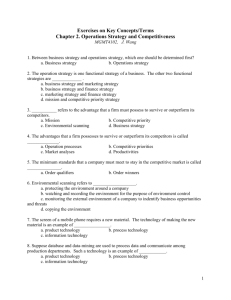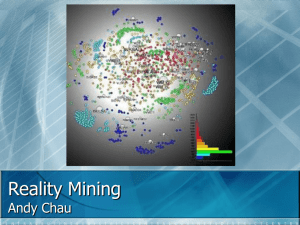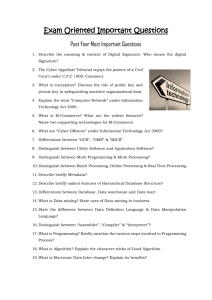Agent-Based Knowledge Discovery
advertisement
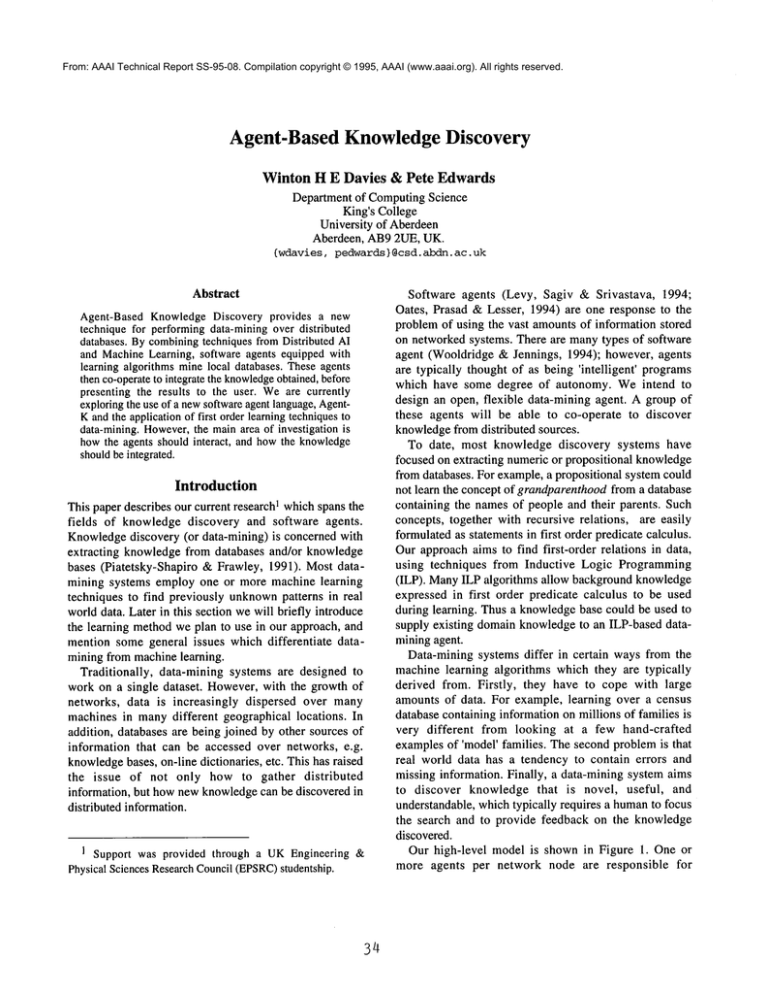
From: AAAI Technical Report SS-95-08. Compilation copyright © 1995, AAAI (www.aaai.org). All rights reserved.
Agent-Based Knowledge Discovery
Winton H E Davies & Pete Edwards
Department of ComputingScience
King’s College
University of Aberdeen
Aberdeen, AB92UE, UK.
{wdavies,pedwards } @csd. abdn. ac. uk
Abstract
Agent-Based KnowledgeDiscovery provides a new
technique for performingdata-mining over distributed
databases. By combiningtechniques from Distributed AI
and MachineLearning, software agents equipped with
learning algorithmsminelocal databases. Theseagents
then co-operateto integrate the knowledge
obtained,before
presenting the results to the user. Weare currently
exploringthe use of a newsoftwareagent language,AgentKand the applicationof first orderlearningtechniquesto
data-mining.However,the mainarea of investigation is
howthe agents should interact, and howthe knowledge
shouldbe integrated.
Introduction
This paper describes our current research1 which spans the
fields of knowledge discovery and software agents.
Knowledgediscovery (or data-mining) is concerned with
extracting knowledge from databases and/or knowledge
bases (Piatetsky-Shapiro & Frawley, 1991). Most datamining systems employ one or more machine learning
techniques to find previously unknownpatterns in real
world data. Later in this section we will briefly introduce
the learning methodwe plan to use in our approach, and
mention some general issues which differentiate datamining from machinelearning.
Traditionally, data-mining systems are designed to
work on a single dataset. However, with the growth of
networks, data is increasingly dispersed over many
machines in manydifferent geographical locations. In
addition, databases are being joined by other sources of
information that can be accessed over networks, e.g.
knowledgebases, on-line dictionaries, etc. This has raised
the issue of not only how to gather distributed
information, but hownew knowledgecan be discovered in
distributed information.
1 Support was provided through a UKEngineering &
Physical SciencesResearchCouncil(EPSRC)
studentship.
Software agents (Levy, Sagiv & Srivastava, 1994;
Oates, Prasad & Lesser, 1994) are one response to the
problem of using the vast amountsof information stored
on networked systems. There are manytypes of software
agent (Wooldridge & Jennings, 1994); however, agents
are typically thought of as being ’intelligent’ programs
which have some degree of autonomy. We intend to
design an open, flexible data-mining agent. A group of
these agents will be able to co-operate to discover
knowledgefrom distributed sources.
To date, most knowledge discovery systems have
focused on extracting numeric or propositional knowledge
from databases. For example, a propositional system could
not learn the concept of grandparenthoodfrom a database
containing the names of people and their parents. Such
concepts, together with recursive relations, are easily
formulatedas statements in first order predicate calculus.
Our approach aims to find first-order relations in data,
using techniques from Inductive Logic Programming
(ILP). ManyILP algorithms allow background knowledge
expressed in first order predicate calculus to be used
during learning. Thus a knowledgebase could be used to
supply existing domainknowledgeto an ILP-based datamining agent.
Data-mining systems differ in certain ways from the
machine learning algorithms which they are typically
derived from. Firstly, they have to cope with large
amounts of data. For example, learning over a census
database containing information on millions of families is
very different from looking at a few hand-crafted
examplesof ’model’ families. The second problem is that
real world data has a tendency to contain errors and
missing information. Finally, a data-mining system aims
to discover knowledge that is novel, useful, and
understandable, which typically requires a humanto focus
the search and to provide feedback on the knowledge
discovered.
Our high-level model is shown in Figure 1. One or
more agents per network node are responsible for
examiningand analysing a local data source. In addition,
an agent mayquery a knowledgesource for existing
knowledge(such as rules or predicate definitions). The
agents communicatewith each other during the discovery
process. This allows the agents to integrate the new
knowledgethey produce into a globally coherent theory.
A user communicateswith the agents via a user-interface.
In addition, a supervisory agent, responsible for coordinating the discovery agents mayexist. The interface
allows the user to assign agents to data sources, and to
allocate high level discovery goals. It allows the user to
critique new knowledgediscovered by the agents, and to
direct the agents to new discovery goals, including ones
that might makeuse of the new knowledge.
>
Ii
< >
[._
~
..a
network
communication
....
User Interface
Each agent has a data-source and a clustering algorithm.
The agents propose rules which characterise the data and
critique other agents’ proposals. Eventually a consensus
about the knowledgeextracted from the data is reached.
ANIMALS
(Edwards & Davies, 1993) is a heterogeneous
multi-agent learning system. Each agent has local
knowledgeand either an inductive or deductive learning
algorithm. Agents attempt to solve a problem-solvingtask
by either retrieving the knowledgerequired, or by using
learning to acquire it. Failures result in communication
with other agents which are passed sub-goals, which are
then treated as tasks. Both MALEand ANIMALS
used
propositional learning methods.
First Order Knowledge Discovery Some ILP systems
have been applied to data-mining. One example is
ENIGMA
(Bergadano, Giordana & Saitta, 1991), which
learnt fault diagnosis rules based on mechanicalvibration
data. Another is GOLEM
(Muggleton, King & Sternberg,
1992), whichlearnt rules that predicted structural features
in newproteins fromexisting protein data.
Multi-Agent KnowledgeDiscovery The Carnot Project
(Woelket al., 1992) addresses the problem of logically
unifying distributed, heterogeneousbusiness information.
It appears that the underlying architecture uses software
agents. Carnot provides a knowledge discovery system,
presumably as an agent. However, we are uncertain
whetherthis agent co-operates with similar agents, and are
unsure as to the exact nature of the learning algorithm
used.
t
I
t
___~_---~
I = networkhost
Figure 1: Data-Mining Using Multiple Agents
As far as possible, our intention is to base our workon
the integration of existing technologies in the field of
softwareagents and first order learning. This is in order to
concentrate on the core issues of distributed data-mining.
We intend to use agents based on Agent Oriented
Programming(AOP) (Shoham, 1990), and the techniques
developed as part of the KnowledgeSharing Effort (Patil
et al., 1992). In addition, we have already identified
numberof recent ILP algorithms, with which we plan to
experiment. These include: the information-gain based
FOCL(Pazzani & Kibler, 1992), CLAUDIEN
(DeRaedt
& Bruynooghe, 1993) and SIERES (Wirth & O’Rorke,
1992).
Related Work
Multi-Agent Learning A number of co-operative
distributed learning systems have been produced. MALE
(Sian, 1991) is a homogeneous,blackboard-based system.
35
Distributed Database Mining One approach which has
emerged for mining distributed databases is to use a
distributed
database manager to provide seamless
integration of the distributed data to data-mining
algorithms (Simoudis, 1994). Our approach differs in that
communicationtraffic betweenagents is restricted to the
exchange of knowledge.
Preliminary Work
To date we have tackled the following issues: the nature of
the agent architecture; and the possible interactions
betweenthe agents during the data-mining process.
Agent-K
The first step in designing our agent was to modify
Agent-0 (Shoham, 1990) to use KQML
(Finin et al., 1993)
communicationperformatives. This is detailed in Davies
& Edwards(1994). Wehope to extend Agent-Kto use the
Knowledge Interchange
Format and Ontolingua
ontologies (Patil et al., 1992). This would allow our
discovery agents to share knowledge with other KSEbased agents. Wealso plan to replace the basic Agent-0
interpreter with a variation on PLACA
(Thomas, 1993),
which would provide agents with a planning capability.
Agents would thus have a means to plan interaction
amongst themselves and with other KSE agents. We
believe that Agent-Khas already been a success, as it has
demonstrated that the AOPapproach is compatible with
that of KQML.
It has also provided a platform that we can
eventually use for data-mining.
Agent-Kprovides a simple production rule mechanism
that is used to program agents. The rules respond to
incoming KQML
messages and the current state of the
agent, and if triggered, undertake a given action. In order
to use the agents to support data-mining, it will desirable
to provide a generalised set of learning actions, whichare
independent of any specific learning algorithm. This set
will have to include actions for negotiation between
agents, about learning results.
Knowledge Integration
in Distributed
Data-Mining
Individual agents will produce new knowledgebased on
their discoverygoals, and the viewof the distributed data.
This knowledgewill have to be integrated, so that it
accountsfor all viewsof the data.
Theory refinement and knowledge integration are
related techniques. Theoryrefinement involves revising a
theory with respect to new training examples. Knowledge
integration involves combiningtwo theories into a single
unified theory. However,the learning techniques used for
both are similar, and ILPalgorithmsin particular appear to
make little distinction between revising clauses in
response to new examples, and combining two sets of
clauses and then revising them to fit the existing
examples(Pazzani & Kibler, 1992).
Our initial decision to use an ILP learning algorithm
was based on the insight that many ILP algorithms
provide support for theory revision and knowledge
integration. An agent based on such an algorithm could be
used to both induce and integrate knowledge.
However, there is far more to consider than simply
choosing an appropriate algorithm. Firstly, we must
consider the nature of the examples(data) and discovery
goals given to each agent. Then we must consider when
the agents should co-operate; either before, during or after
learning. Finally, if we decide that the co-operation should
take place after learning, we have to decide how the
agents will integrate the set of local results in order to
reflect a global solution to the data-mininggoal.
Heterogeneous vs. HomogeneousData-Mining If each
agent in the systemis associated with a single database,
then there are twobasic types of interaction to consider. If
each agent has the same discovery goal, and the same
36
database schema (though normally containing different
values), then we refer to this as homogeneous datamining. In this case the problem for the agents is to
resolve partial results based on each partial view of the
entire data.
If each agent has a different database and discovery
goal, then the agents may use theories found by other
agents as sub-theories. For example, if one agent learns a
’definition of parent, then a secondagent might use this in
its definition of grandparent. Werefer to this as
heterogeneous data-mining.
Distributed Learning There are three ways learning can
occur when data is distributed. These relate to when
agents communicatewith respect to the learning process.
As mentioned above, they can communicate before,
duringor after learning.
The first approach gathers the data into one place. The
use of distributed database management systems to
provide a single set of data to an algorithm is one example
of this.
The second approach is for agents to exchange
information whilst learning on local data. This is the
approach taken by Sian (1991). No integration step
needed, as the agents are effectively workingas a parallel
algorithm over the dataset. This restricts the agents to
using a single, highly specialised learning algorithm.
Thethird approachis for the agents to learn locally, and
then to share their results, which are then modified by
other agents in light of their owndata and knowledge.
This allows each agent to use a different algorithm if
required. However,it raises the question of howall the
local results should be integrated.
Knowledge
Integration If the latter approach is adopted,
then the local theories have to be integrated. It must be
rememberedthat each agent’s local results are correct for
that agent’s view of the data. Thus the fundamental
problem is to compare local theories with previously
unseendata, i.e. other agent’s data. This data is of course
summarisedby the results produced by the other agents.
There appear to be three alternatives for producing a
single, global result.
The first approachinvolves a supervisor agent, in which
one agent attempts to integrate all the local theories.
However, this may lead to the transmission of large
amountsof the original data, in order to test the accuracy
of the new knowledge.
The second is a democratic version of the supervisor
approach, with the agents workingas a team to integrate
their local results.
The third approach involves each agent taking other
agent’s theories and integrating themlocally.
As can be seen from this discussion, the question of
knowledgeintegration is a fundamental one in creating a
distributed data-miningarchitecture.
Conclusions
This paper describes our work to date on an agent-based
approach to distributed knowledge discovery. Weare
currently investigating the application of ILP algorithms
to data-mining tasks, and plan to adapt the selected ILP
algorithm to workas an agent. Westill have to decide how
the agents will co-operate, and must produce an interface
that will allow a user to interact with the agents.
A considerable number of issues have been raised
during this work. For example, if agents interact during
learning, someagents maybe forced to wait while agents
are still performing discovery. If agents interact upon
completion of learning, knowledge integration may be
computationally intensive. Anotherquestion is howagents
should be selected to workon a given discovery goal. This
might be addressed by the work on Site Description
Languages(Levy, Sagiv & Srivastava, 1994).
Our long term goal is that agent-based knowledge
discovery will allow distributed databases to be minedin a
distributed manner: maximisingthe usage of distributed
computingresources, and minimisingnetwork traffic.
References
F. Bergadano, A. Giordana & L. Saitta, Integrated
Learning in a Real Domain,in KnowledgeDiscovery in
Databases, G. Piatetsky-Shapiro &W.J. Frawley (Eds.),
MITPress, 1991, 277-288.
W. Davies & P. Edwards, Agent-K: An Integration of
AOP and KQML,in Proceedings of the CIKM’94
Intelligent Information Agents Workshop,Y. Labrou &
T. Finin (Eds.), 1994.
L. DeRaedt & M. Bruynooghe, A Theory of Clausal
Discovery,
in Proceedings of the Thirteenth
International Joint Conferenceon Artificial Intelligence
(IJCAI93), R. Bajcsy (Ed.), Morgan Kaufmann, 1993,
1030-1036.
P. Edwards & W. Davies, A Heterogeneous Multi-Agent
Learning System, in 1993 Proceedings of the Special
Interest Group on Co-operating Knowledge Based
Systems, S. M. Deen(Ed.), University of Keele, 1993,
163-184.
T. Finin et al., DRAFT
Specification of the KQML
AgentCommunicationLanguage, 1993, unpublished draft.
A. Y. Levy, Y. Sagiv &D. Srivastava, TowardsEfficient
Information Gathering Agents, in Papers from the AAAI
Spring Symposium on Software Agents, Technical
Report SS-94-03, AAAIPress, 1994, 64-70.
37
S. Muggleton, R. King &M. Sternberg, Protein Secondary
Structure Prediction using Logic, in Proceedingsof the
Second International Workshop on Inductive Logic
Programming,ICOT, Tokyo, Japan, 1992.
T. Oates, M. V. N. Prasad & V. R. Lesser, Co-operative
Information Gathering: A Distributed Problem Solving
Approach, Technical Report Computer Science 94-66,
University of Massachusetts, 1994.
R.S. Patil et al., The DARPA
KnowledgeSharing Effort:
Progress Report, in Proceedings of KA92- The Annual
International Conference on KnowledgeAcquisition,
Cambridge, MA,1992.
M. Pazzani & D. Kibler, The Utility of Knowledgein
Inductive Learning, MachineLearning, 9, 1992, 57-94.
G. Piatetsky-Shapiro
& W. J. Frawley, Knowledge
Discovery in Databases, MITPress, 1991.
Y. Shoham, Agent-Oriented Programming, Technical
Report STAN-CS-90-1335,Stanford University, 1990.
S. Sian, Extending Learning to Multiple Agents: Issues
and a Model for Multi-Agent Machine Learning (MAML), in Proceedings of the European Working Session
on Learning - EWSL91,Y. Kodratroff (Ed.), SpringerVerlag, 1991, 458-472.
E. Simoudis, personal communication, 1994.
S.R. Thomas, PLACA, an Agent Oriented Programming
Language, Ph.D. Dissertation,
Computer Science
Department,Stanford University, 1993.
R. Wirth & P. O’Rorke, Constraints for Predicate
Invention, in Inductive Logic Programming, S.
Muggleton(Ed.), AcademicPress, 1992, 299-318.
D. Woelk, W. M. Shen, M. Huhns & P. Cannata, Model
Driven Enterprise Information Managementin Carnot,
in Enterprise Integration Modelling: Proceedingsof the
First International Conference, MITPress, 1992.
M. Wooldridge & N. R. Jennings, Intelligent Agents:
Theory and Practice,
submitted to Knowledge
Engineering Review.
